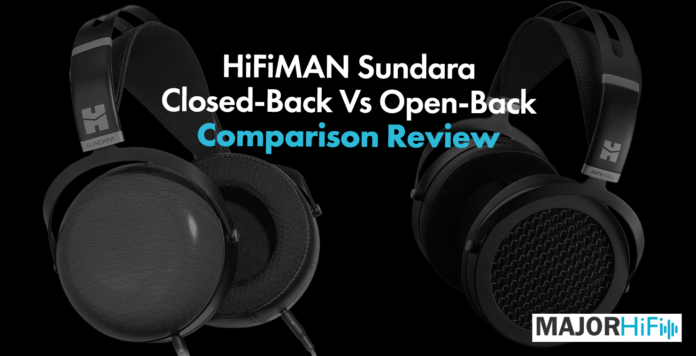There is a new closed-back version of the HiFiMAN Sundara, and there is a lot to praise about it. In my review, I could not help but compare it to the popular open-back version at some points. So, I thought it would be best to thoroughly compare the two Sundaras in all of their aspects.
What You Get
| HiFiMAN Sundara Open-Back | HiFiMAN Sundara Closed-Back |
|
|
Look and Feel
The closed-back Sundara is basically built like the open-back version but with wooden cups attached to them. They both contain the same basic frame and suspension headband. Build quality is solid, and the closed-backs beechwood shells are aesthetically pleasing. One of the main differences here is comfort. Both headphones are very comfortable, but the closed version feels like it has a bit more weight to it. This makes sense due to the open version naturally being lighter.
Design
The open-back Sundara I am using for this comparison is the V2 version. It houses most of the same features as the closed-back version, like the supernano diaphragm, but leaves out a major component. The closed-back Sundara has stealth magnets, working to significantly detract unwanted resonances. It also has a lower impedance than the open-back version, but you should be able to drive both headphones from a majority of DAC/amps and simple adapters.
Soundstage
When you’re comparing open and closed-back soundstages, there is usually a clear winner. Here, I think both headphones make a case for their display of sound elements. For example, the Sundara as a closed-back headphone performs wonderfully. Its spatial imaging is highly immersive and articulate when compared to other closed-back headphones in its price range. However, when you compare it to the open-back Sundara, the closed version loses some qualities. Specifically, the closed version loses some considerable headspace, leaving less breathing room for the mix.
You don’t have this problem with the open-back version just by the nature of its design. Of course, the open-back is going to leave you with more headspace, but you also get a much floatier sound environment. In the closed version, the instruments have a much stricter placement of elements. Instruments contain dimension but were more solidified in a traditional stereo field. The open Sundaras appear more holographic, wrapping the soundstage around you and placing elements above your head.
Low End
The low end of both Sundara’s is the most eventful area of their respective sound signatures. They both offer a gratifying bass tone that gives you a ton of impact. The main difference here is that the open-back Sundara feels too spread out with its resonance, whereas the closed-back concentrates and solidifies the performance. I believe that this is the closed-back version’s greatest strength over the open version, as it heightens the clarity while maintaining the powerful response of the bass. There is a lot more finesse to the bass in comparison to the open version which feels a little too broad. The bass on the open-back Sundara has great lift and punch but spreads out its frequency contents too far. This makes it lack a bit of consistency, and the closed version doesn’t have this issue.
Mids
Both headphones also bring a lot of character to their midrange output. Their biggest similarity is their warmth, bringing closeness and texture to instruments. There is a strong body to each note articulated through both Sundaras. Where these headphones start to differ in the midrange has more to do with their spatial dynamics. The open-back Sundara is better at expressing individualized sound elements, while the closed version is more linear in its tone. Instruments are still expressive in the closed version, but their response is not as lush as in the open version. However, the closed-back Sundara seems to have a crisper vocal response to me.
Highs
If you prefer an airy treble, then the open-back Sundara is going to be the one to go for. The closed version has nice highs but the airiness is reduced considerably. Their timbre is not as energetic, remaining more neutral in the mix. With the open-back Sundara, you get a colorful response that dispenses detail all around the top end of the sound signature. Both headphones have a very digestible treble response, but you’ll get more sizzle and sparkle from the open-back Sundara.
Summary
Deciding which version of the Sundara to buy will mainly depend on whether or not you are looking for open or closed-back headphones, but there are other qualities to consider. For instance, I find the bass on the closed version to be noticeably better in their performance, but the highs on the open version are way more detailed. Both Sundaras are great headphones for their price, whether or not you prefer open to closed-back.
The HiFiMAN Sundara Open-Back and Sundara Closed-Back are available at Audio46.
Compare the ranking of various headphones, earbuds and in-ear monitors using our tools.
Discuss this, and much more, over on our forum.
---MAJORHIFI may receive commissions from retail offers.















